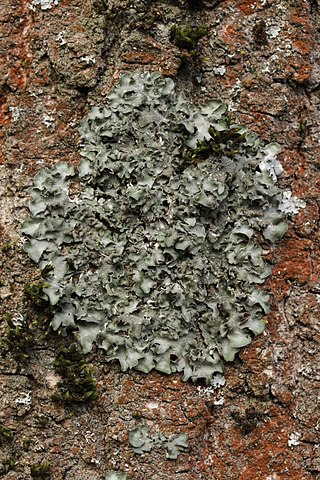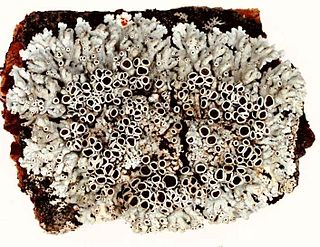Geltingia is a fungal genus in the family Helicogoniaceae. It is monotypic, containing the single lichenicolous species Geltingia associata. The genus was circumscribed in 1990 by mycologists Vagn Alstrup and David Leslie Hawksworth. The genus name honours Danish scientist Paul Gelting.
Endococcus is a genus of lichenicolous (lichen-dwelling) in the family Lichenotheliaceae. It has 44 species. The genus was circumscribed by the Finnish botanist William Nylander in 1855. Although at least one source places the genus in the Verrucariaceae, a 2016 study of the type species, Endococcus rugulosus, determined that it should instead be placed in the family Lichenotheliaceae of the order Dothideales; this classification echoes a placement proposed in 1979 by David Hawksworth.

Peltigera aphthosa is a species of lichen known by the common names green dog lichen, leafy lichen, felt lichen, and common freckle pelt. It has a circumpolar distribution, occurring throughout the Arctic, boreal, and temperate regions of the Northern Hemisphere.

Candelariella vitellina is a common and widespread green-yellow to orange-yellow crustose areolate lichen that grows on rock, wood, and bark, all over the world. It grows on non-calcareous rock, wood, and bark.

Lecanora cenisia is a species of crustose lichen in the family Lecanoraceae. It is a known host of the lichenicolous fungus species Carbonea supersparsa.

Lecanora polytropa, commonly known as the granite-speck rim lichen, is a species of saxicolous lichen in the family Parmeliaceae. A small, inconspicuous species that grows in the cracks of rock surfaces, it has a cosmopolitan distribution and has been recorded on all continents, including Antarctica.

Pleurosticta acetabulum is a species of foliose lichen in the family Parmeliaceae. It is common and widespread throughout Europe, where it grows on tree bark. It has also been recorded in Algeria.
Lichenopeltella rangiferinae is a species of fungus belonging to the class Dothideomycetes. It was discovered growing on Cladonia rangiferina in Hrútey near Blönduós, Iceland and subsequently described as new to science in 2011.
Lichenopeltella santessonii is a species of lichenicolous fungus belonging to the class Dothideomycetes. It was first formally described as a new species of Micropeltopsis in 1990 by mycologists Paul Kirk and Brian Spooner. The specific epithet honours Swedish lichenologist Rolf Santesson, who collected the type specimen in Sala Municipality, Sweden, where it was growing on the foliose lichen Peltigera canina. Santesson transferred the taxon to the genus Lichenopeltella in 1993.
Carbonea supersparsa is a species of lichenicolous fungus belonging to the family Lecanoraceae. It is widespread in the Northern Hemisphere. In Iceland it has been reported growing on Lecanora cenisia near Egilsstaðir and Lecanora polytropa near Seyðisfjörður.

Carbonea vitellaria is a species of lichenicolous fungus belonging to the family Lecanoraceae. It has a worldwide distribution. In Iceland it has been reported growing on Candelariella vitellina near Egilsstaðir and on King George Island, Antarctica.

Muellerella lichenicola is a species of lichenicolous fungus in the family Verrucariaceae. It was first formally described as a new species in 1826 by Søren Christian Sommerfelt, as Sphaeria lichenicola. David Leslie Hawksworth transferred it to the genus Muellerella in 1979.
Lichenopeltella cetrariae is a species of fungus belonging to the class Dothideomycetes. It has been found growing on Cetraria aculeata in Hrútey near Blönduós, Iceland and on Cetraria laevigata in Bulgan district, Mongolia and Toyama prefecture, Japan. In Japan, it has also been reported growing on Flavocetraria cucullata in Yamanashi prefecture and Nagano prefecture.

Variospora aurantia is a species of lichen belonging to the family Teloschistaceae. In Sicily, it has been reported as a host for the lichenicolous fungus species Muellerella lichenicola.
Lichenopeltella uncialicola is a species of fungus belonging to the class Dothideomycetes. The species was discovered in Iceland in 2010 where it was found growing on Cladonia uncialis. Since then, it has been found on a different host species, Cladonia rangiferina, in North-Korea, Italy Austria, and Greenland.

Lichenoconium pyxidatae is a species of lichenicolous fungus belonging to the class Dothideomycetes. It has a Holarctic distribution being found in Alaska and various parts of Russia, including Siberia, Franz Josef Land, Novaya Zemlya and Wrangel Island.

Muellerella pygmaea is a species of lichenicolous fungus in the family Verrucariaceae. It has a cosmopolitan distribution in Arctic-alpine areas and grows on the thallus and apothecia of a number of hosts.

Polycoccum is a genus of lichenicolous fungi in the family Polycoccaceae. It has about 60 species.

Physcia aipolia, commonly known as the Hoary rosette lichen, is a lichen species of fungus in the genus Physcia, and family Lecanoromycetes. Physcia aipolia is a species of lichen in the family Physciaceae. It has a worldwide distribution.Physcia aipolia is a known host species to the lichenicolous fungus species Muellerella lichenicola. It is characterized by the pale blue to gray thallus with many apothecia. Physcia aipolia is a common, widely distributed species, and can be found growing on a variety of trees and branches.
Zwackhiomyces echinulatus is a species of lichenicolous (lichen-dwelling) fungus in the family Xanthopyreniaceae. Thus fungus exclusively colonises the lichen species Physconia distorta. This fungus is notable for specific structural features that distinguish it from other members of its genus, and for its niche habitat found only in particular regions of Sicily, Italy.












